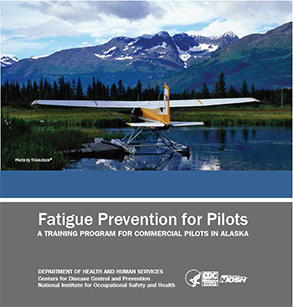Fatigue Prevention for Pilots: A Training Program for Commercial Pilots in Alaska
December 2016
DHHS (NIOSH) Publication Number 2016-162

Fatigue is a general lack of alertness and degradation in mental and physical performance, and can affect pilot alertness, performance, and judgment during flight. Pilot fatigue has been documented as early as 1927 when Charles Lindbergh crossed the Atlantic Ocean. The National Transportation Safety Board listed reduction of fatigue-related accidents on their list of Ten Most Wanted Transportation Safety Improvements for 2017-2018, and the Department of Transportation identified the issue of pilot fatigue as a top priority during a 2009 airline Safety Call to Action, following the crash of Colgan Air flight 3407. On December 21, 2011, the Federal Aviation Administration issued a final rule for flight, duty and rest times for commercial pilots flying large passenger aircraft.
In order to help pilots avoid flying fatigued, NIOSH recently completed a fatigue prevention training for commercial pilots in Alaska. This training can be used by individual pilots, or by companies as part of their initial or recurrent training programs for pilots. The training may also be used by any individual pilots who are not flying as commercial pilots.
The training can be downloaded here: Fatigue Prevention for Pilots: A Training Program for Commercial Pilots in Alaska.
Hard copies are available at no cost by emailing aviation@cdc.gov
- Page last reviewed: January 19, 2017
- Page last updated: January 19, 2017
- Content source:
- National Institute for Occupational Safety and Health Education and Information Division


 ShareCompartir
ShareCompartir